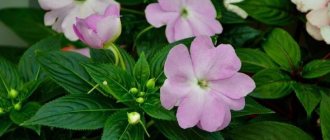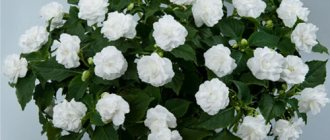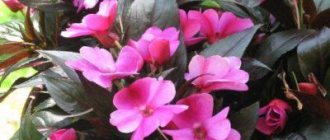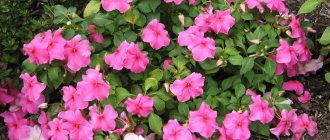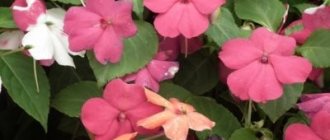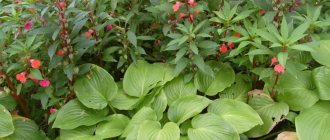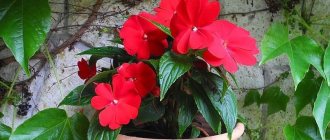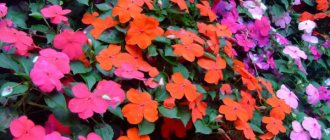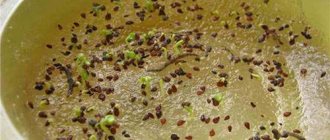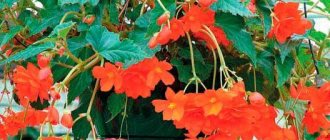The beautiful and very delicate plant impatiens (impatiens family) belongs to a large genus called Impatiens. It has over 500 plant species. The garden “career” of these plants developed with varying success: there was a time when they were admired, and then undeservedly forgotten.
Today, they are again attracting the attention of gardeners and flower lovers. Yellow, purple, crimson, pink flowers, long flowering are the main distinguishing features of these plants.
Spreading
The impatiens are native to the Himalayas. It was brought in as an ornamental plant. Prefers moist, shady areas and grows along the banks of rivers and lakes. The plant grows under natural conditions most often in tropical Africa and Asia, some representatives of the genus grow in America and Europe.
In our country, almost everywhere you can find impatiens vulgaris with small or large yellow flowers, as well as glandular, which has pink flowers. We will talk about them in this article.
Features of care
Caring for crops in the garden and in the apartment is not difficult - care consists of watering, fertilizing, and treating against insect pests and diseases.
The plant needs to be watered depending on the season - in the summer when it’s hot almost every day, in the winter - after the top layer of soil has dried. In an apartment, the air is dry and should be humidified with a spray bottle, helping the plant lose moisture from the surface of the leaves.
Terry balsams bloom actively and abundantly for a long time, and fertilizing replenishes the consumption of nutrients from the soil. For fertilizer, organic and mineral substances are used alternately, once every 1.5 weeks, controlling the application of nitrogen so as not to provoke excessive growth of green mass.
Over the winter, the stems stretch and lose their attractiveness, so in the spring long shoots are cut to ½ length. To form the required size of the bush, the tops are pinched when the shoot reaches a certain length, weak and thin stems are cut off. This procedure activates the growth of young shoots and abundant flowering.
With a lack or excess of moisture, hypothermia, poor lighting, the bushes begin to shed their leaves, buds, stems and leaves change color to lighter tones. Eliminating the cause returns the plant to its previous healthy state.
Transfer
You can transplant balsam into a new pot in spring or summer, but you should take into account an important feature - the plant blooms well when the roots in the pot do not have enough volume.
Largely overgrown bushes, whose roots are intertwined and do not have enough nutrition in an overly cramped container, are transplanted. Old stems should be cut off, thereby stimulating the growth of young shoots. Bushes at the age of 1 year can be transplanted into another larger pot in a coma of earth. It is better not to replant adult balsams, more than 3 years old, but to renew them by planting cuttings.
Information! Due to the difficulties of collecting seeds, it is better to purchase them in a store.
Pest and disease control measures
Balsam responds to violations of the watering and fertilizing regime by deteriorating its condition, which can cause damage by pests: aphids, meadow bugs, whiteflies, strawberry mites. Timely treatment with insecticides Bona Forte and Bitok-Sibacillin helps to cope with them quickly.
If the soil is excessively moistened, the root system becomes infected with gray rot. The bush should be removed from the pot, the roots should be freed from the soil, washed, the affected roots should be removed and replanted in new soil.
For preventive treatment against powdery mildew and viral mosaic, a solution of Bordeaux mixture is used.
Terry impatiens Impatiens is an excellent ornamental crop for the garden and apartment. The varied colors of flowers and leaves give the site an unusually beautiful exotic look and, importantly, the culture is not capricious and does not require much effort in cultivation and care.
Impatiens vulgare
Herbaceous annual plant up to 80 cm high with an erect succulent stem and fibrous branched root. The leaves are petiolate, alternate, with large teeth along the edge, oval.
The flowers are drooping, irregular, lemon-yellow in color, with a spur, usually collected in racemes. The fruit is an oblong capsule. During ripening, when you touch it, it cracks and forcefully throws out the seeds contained inside. Impatiens vulgaris blooms from the second half of June until the end of September. Prefers damp, shaded areas and forms impenetrable thickets.
The chemical composition of this plant has not yet been sufficiently studied. It is known for certain that during flowering, impatiens contain 68.5% vitamin C.
How to plant seedlings correctly
A comfortable microclimate and the brightness of the spring sun contribute to rapid flowering. Strong seedlings are planted in loamy soil, generously fertilized with organic fertilizer (manure). It is better to do this in mid-June, when there are no night frosts. In order not to expose the plants to stress, it is necessary to remove them together with a wet earthen lump. Single specimens are planted in holes corresponding to the height of the pot at a distance of 25 cm. Soil:
- compacted,
- mulched,
- watered
In order for the flower to quickly adapt to a new environment, the root shoots are immediately pinched.
If the summer promises to be warm, you can sow the seeds directly into the ground in May. At night, the plantings will have to be covered with a blanket. At a stable temperature (from + 21°), the first shoots appear after 18 days. The fragility of the stem and the tenderness of the petals determine the location of the flowerbed. The balsam dies in an area blown from all sides by the wind. Otherwise, a protective curtain is hung or the flower garden is surrounded by a decorative fence. The heat-loving plant is comfortable in partial shade. Withered leaves and pale color are signs of intolerance to hot rays. At noon, it is better to cover the flowers with an improvised tent.
The growing season ends with yellowing of the boxes. If you want to extract the contents for sowing next spring, it is better to remove them unripe and place them on the windowsill, otherwise the seeds will scatter throughout the garden. Later, husk, pour into a rag bag, and leave in a dry place until February.
Use of impatiens vulgare
The plant is used only by traditional healers. An infusion of the herb is taken as an anti-inflammatory and diuretic for diseases of the bladder, kidneys, edema, and kidney stones. In addition, it is also used as an emetic. Wounds and ulcers are washed with infusion of herbs. Baths with infusion give a good effect for joint pain. Crushed leaves are applied to bruises and hemorrhoids.
Impatiens vulgaris has long been successfully used by folk healers. For medicinal use, the plant is cut off entirely during flowering. Dry the raw materials by laying them out in the shade or in a well-ventilated area. Impatiens is used for external and internal bleeding, for stones in the bladder and kidneys.
Medicinal properties
Balsam herb is used to prepare a medicine for crushing and removing stones from the kidneys and bladder. This feature of the plant requires careful dosing. Excessive use of infusions can cause the opposite effect, which manifests itself in side effects (vomiting, etc.).
The medicinal properties of impatiens lie in its composition. The ability to remove excess fluid should be taken into account in order to regulate water balance. Aqueous solutions based on seeds and stems have the ability to suppress the growth of Staphylococcus aureus, the causative agent of dysentery. The roots of the plant with flowers are recommended to be used as an anesthetic.
Preparing the infusion
Brew two tablespoons (tablespoons) of crushed raw materials into 500 ml of boiling water in a thermos. Leave it to steep for five hours. After this time, strain. Take the product warm. During the day you need to drink 200 ml of the product in equal parts. Impatiens acts on the uterus, causing its intense contraction with heavy bleeding. In addition, this infusion is recommended for the treatment of bleeding from the bladder and rectum. It is used externally to treat ulcers, wounds, and hemorrhoids.
Impatiens vulgaris is a honey-bearing, medicinal, dyeing and poisonous plant. You shouldn’t get carried away with self-medication, even if someone you know advises you to “drink weed.”
Impatiens glandular: description
This is also an annual. Grows up to two meters. The stems are straight, have internodes, often transparent, juicy, filled with juice. The leaves are alternate, elliptical in shape, entire. The plate is shiny and delicate. Their length is 10 cm, the edges are jagged.
The second name of the plant is ferruginous balsam (iron-bearing balsam). The stem of the plant is thick, highly branched, knotty, and succulent. The leaves are ovate-lanceolate and can reach 12 cm in length. They are serrated along the edges, with winged petioles. At the top of the stem they gather in whorls.
The wine-red, white, and pink flowers of this type of impatiens are large, simple, and collected in umbrella-shaped clusters of 10-14 pieces. The petals are 3-3.5 cm long. The flowers have a delicate and delicate scent and are pollinated by various insects, but most often by bumblebees.
Impatiens glandular has interesting features. During flowering, its leaves secrete drops of sweet and aromatic juice along the edges, which forms sugar crystals upon evaporation. They attract ants. During flowering, the peduncles lengthen significantly and hide, like under an umbrella, under the leaves, protecting the flowers from the rain.
The diameter of the flower (with sufficient heat and moisture) is 3 cm. In dry years, impatiens glandular is covered with small flowers, although in large quantities. They are more closed, but when the seeds from these flowers fall into a fertile environment, they produce beautiful large, well-developed flowers.
The fruit is an oblong multi-seeded juicy capsule, which consists of five valves. During ripening, the junctions of the valves become weak, and the capsule is constantly under tension. If you slightly shake the stem or slightly touch the capsule, it immediately breaks with a bang, and the dark brown seeds are scattered with force over a distance of up to two meters. Many new plants grow from them every year. Seeds are dispersed by birds and animals over long distances. They do not lose their viability for eight years.
Reproduction methods
Since garden balsam does not tolerate negative temperatures, it is grown as an annual and most often propagated by seeds. For this purpose, gardeners prepare seedlings or sow directly into the ground.
Another method of propagation is by dividing the bush. The plant is dug up in the fall, before frost sets in. After transplanting into a flower pot, garden balsam is grown at home, caring for it until spring. With the onset of the new season, the bush is divided into parts and planted.
An effective method of propagation is by cuttings. A part of the stems 10-15 cm long is cut from the mother bush and lowered into water. Rooted cuttings are planted in the soil. To speed up root formation, the leaves on the planting material are shortened, and a growth stimulator is added to the water.
Touchy and magic
In ancient times, it was believed that the impatiens glandular was capable of magically opening locks and destroying prison bolts with one touch. It was believed that the flower could tear gold and silver, iron and copper into small pieces. Thieves who found a touch-me-not made a cut in the palm of their hand, inserted grass into it, and then healed the wound. At the touch of such a hand, locks allegedly fell from the doors.
People believed that everyone who simply carried this plant in their pocket was reliably protected from any bullet. This herb, thrown into the enemy’s forge, deprived him of the ability to forge iron. But not every touch-me-not had magical properties, but only those that were obtained in compliance with special rituals.
It was necessary to find a hollow in which the woodpecker had built a nest, and at the same time there were already chicks in it. Then we had to wait for the mother bird to fly away, and then close the nest tightly. Seeing that the nest is closed, the bird will definitely bring an impatiens stem. With his light touch the hollow will open. At this moment, the observing person should have screamed loudly so that the frightened bird would drop the grass.
Chemical composition of balsam
Since the plant is not used in traditional medicine, its chemical composition has not been fully studied. Despite this, a general study of balsam revealed the following substances in its composition: saponins, ascorbic acid, balsaminosterol, fatty oil, parinorrhic acid, bitterness, essential oil, resinous compounds, caffeic acid, vanillic acid, ceryl alcohol, quercetin, kaempferol, tannins, alkaloids, sugars, glycosides, proteins and amino acids.
Due to these substances, impatiens have many medicinal effects against various diseases. Often, the plant can easily replace expensive medications.
Breeding in the garden
Impatiens glandularis is the largest plant of its genus. It is rarely grown in rural front gardens, since it produces abundant self-sowing, often “runs away” behind the fence and forms solid thickets of succulent stems. And gardeners and owners of country houses love balsams. They look great in a border, edging, or as the centerpiece of a flower bed.
Impatiens can also become a perennial plant. If you grew it in the garden or on the balcony, cut the cuttings and grow the flower indoors in winter. The only drawback of this procedure is the falling of leaves in insufficient light.
It is best to plant impatiens in the garden, in a well-ventilated, fairly sunny location with soil rich in organic matter. Gardeners need to know that impatiens take a lot of nitrogen out of it, and therefore grow quite quickly. On poor soils they almost never reach their maximum size. Impatiens especially do not like thickening: the plants become stunted and flowering ends very quickly.
This type is not used in medicine. Gardeners need to be careful when working with this plant. The fact is that impatiens glandular is poisonous. And one more piece of advice. You should not plant this plant if there are small children in the family.
What plants does it go with?
As you can see in the photo, with proper planting and care of street balsam flowers, you can create unique compositions. This is facilitated not only by the extraordinary brightness of the buds, but also by the duration of flowering of the plant. Impatiens looks impressive in individual and group compositions, in rock gardens, rocky gardens, near ponds and at the entrance to the house.
Garden balsam goes well with hosts, boxwood, bells and begonias.
